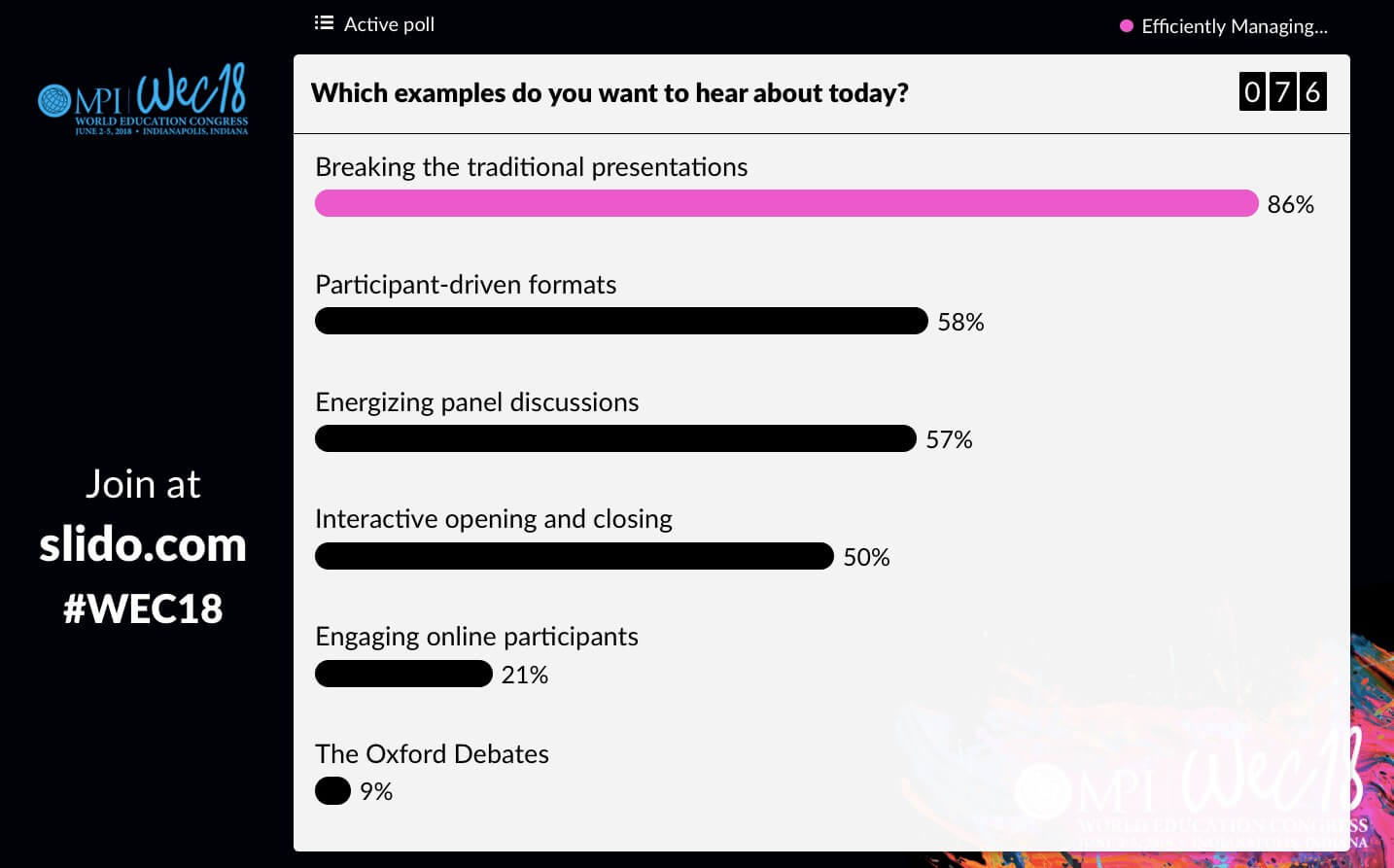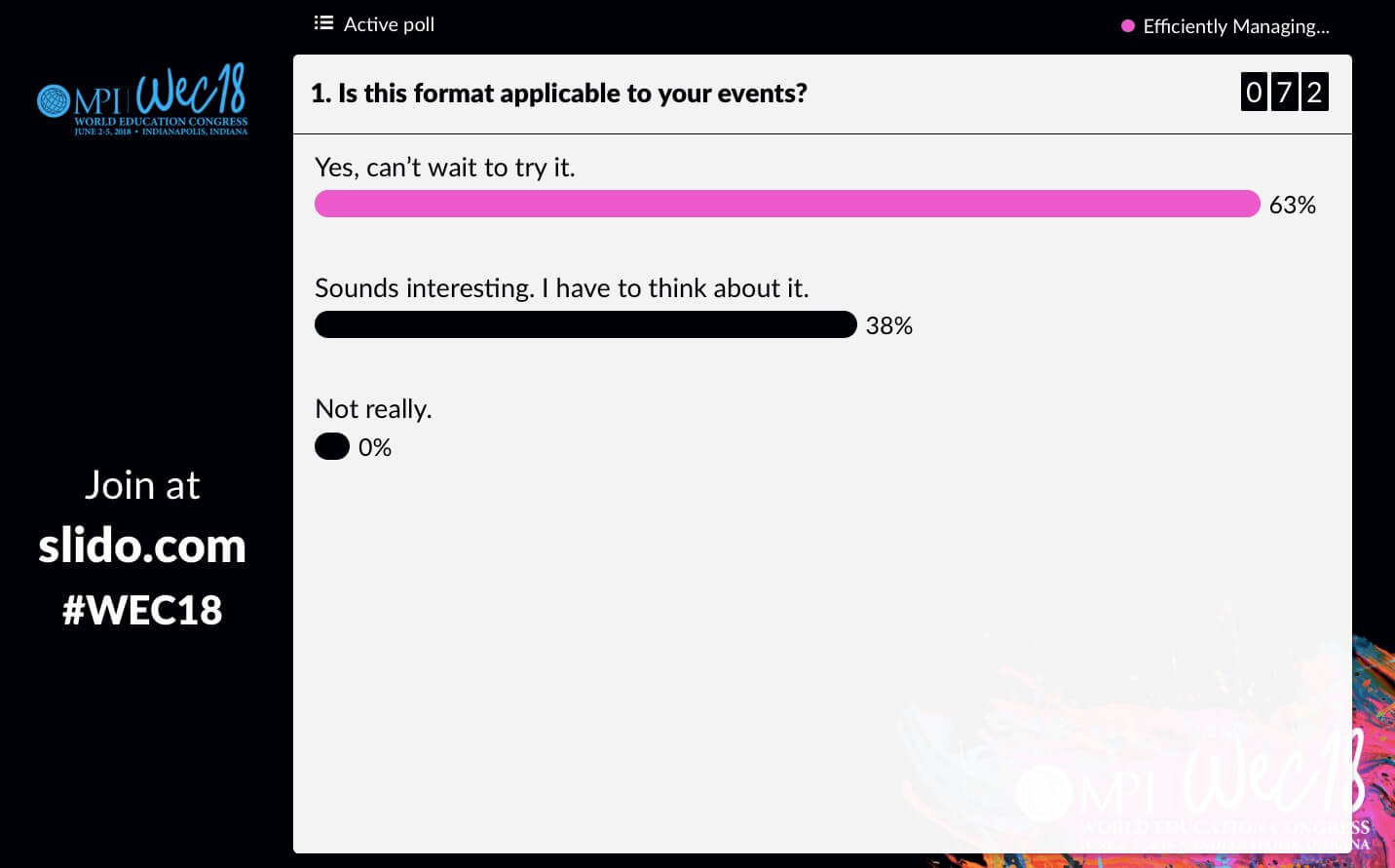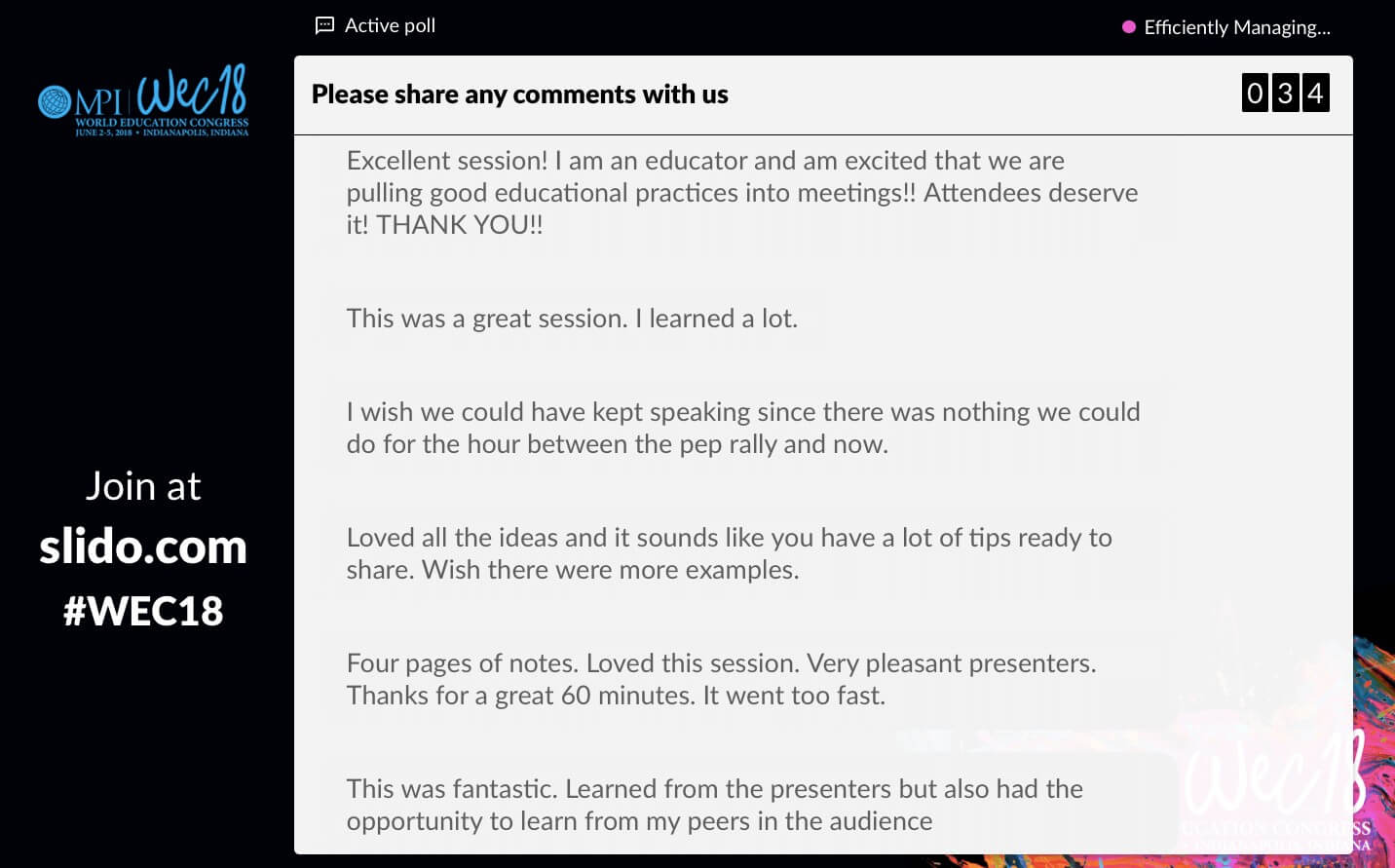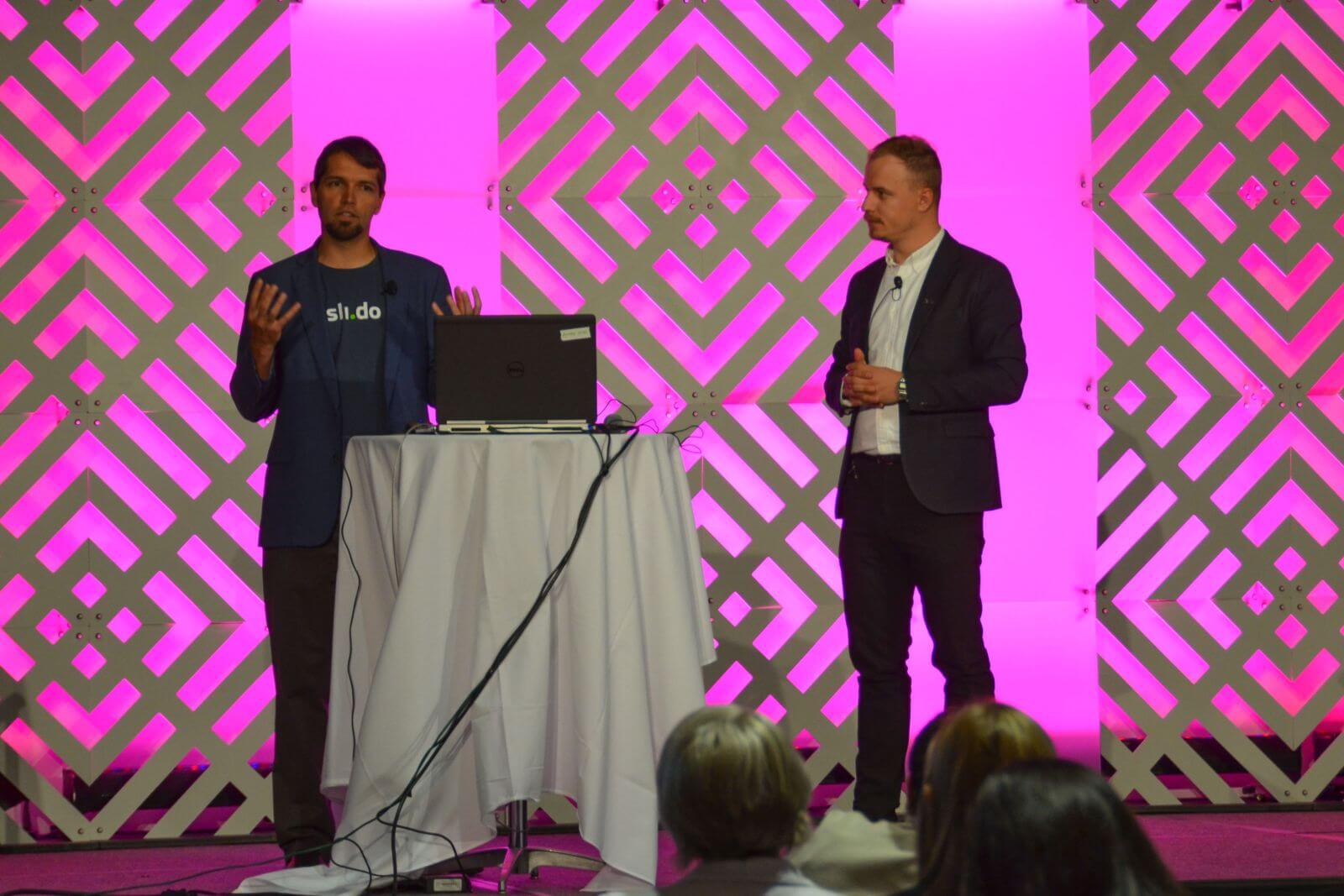The World Education Congress (WEC) is the TED for event professionals. Ever since we entered the industry, it has been our dream to spread our ideas there.
After almost five years, it was a big thing for us to host our own session on The Rise of Conversational Presenting at WEC 2018 in Indianapolis. Talking about conversations, we didn’t want to fail to engage our audience. So we took the interaction as seriously as the content itself.
Along the way, we gained lots of insights. Here are our key learnings.
Find the right spot onstage
Getting the position onstage right was one of the key drivers in generating the interaction we had hoped for.
We checked the room setup the night before and faced a dilemma. The podium placed onstage felt very cold and distant. We ditched that idea instantly.
Instead, we considered putting two chairs on the stage as we were to deliver the talk in tandem. Soon enough, we realized that it wouldn’t serve our purpose. As co-speakers, you can have a conversation either with one another or with the audience. We wanted to achieve the latter.
Luckily, there was a bar table on the ground where we set up shop. Peter stood on one side, I on the other.
On the day, this not only allowed us to converse with one another but also step from behind and walk among the audience. I ran around the room with a mic while Peter focused fully on questions and gave speedy answers.
Being physically close to the audience was critical for creating a bond with the audience. We could never have achieved that from up on the stage. The physical barrier was just too great.
Speaker tip: Check the room ahead of time; if possible, a day or night in advance. Get into the participants’ shoes and sit in the empty audience seats to imagine how the participants will feel when they will be watching you. Based on this, find the best spot to deliver your talk and interact with the audience.
Use the seating setup as your interaction sidekick
The room setup can turn into your best friend or worst enemy when it comes to interaction. We’ve experienced both scenarios.
For our first session, the room was set with roundtables. It was great. The second one was hosted in a theatre setting. It was not so great.
Let’s focus on the first one. Having roundtables made a huge difference to the level of engagement that we managed to generate.
Before we started, the participants made spontaneous introductions and conversed while they were waiting for the session. Networking and learning began even before we uttered a single word.
During the session, it was easy to assign tasks and get people to brainstorm the ideas as they were naturally split into small groups.
After the talk as we were hanging around the room, we got invited by the participants to share more ideas with them. This turned into an impromptu 20-min private session.
We didn’t achieve any of the before and after action in the theatre setting. But with a bit of facilitation and the right instructions, we managed to form groups and trigger conversations even in this stiff environment.
Speaker tip: To create better interaction, ask for a seating setup where you can walk easily among the audience. Depending on the activities, consider a setting that allows for group discussions to take place, such as roundtables, seating pods or movable furniture.
Design interaction points
Conversational presenting is about leading a dialogue with the audience. But it is also about creating opportunities for the participants to converse and share insights with one another.
To walk the talk, we inserted interaction points that allowed us to achieve that. Here is what we used.
Interactive opening
At the very start, we asked people to close their eyes and think of the presentation session that had impressed, influenced or inspired them. After 30 seconds of reflection, they shared their dream session with their neighbours. Once done, we asked them to describe it using one word to create a word cloud.

In the next step, we asked them to think of the usual experience of attending learning sessions and describe it again using a single word. To make the whole exercise brisk, they just typed adjectives.
The aim was to contrast the desired state with the reality and motivate them to look for the tips that will help them get closer to their dream session.
Selection poll
Our overall goal was to make the session as relevant as possible. So after the opening exercise and introduction to the topic, we let the participants pick three out of six use cases that they were the most eager to hear about. Based on the results, we shared the first, second and third most voted options.

Feedback poll + room comments
Still, we were interested in knowing if we were hitting the mark. After each use case, we polled the audience to find out how applicable the tips we’d just shared were to their own events.

It was not only about collecting the poll votes. We walked into the audience and asked people to share their thoughts. This was the most valuable part as people spontaneously contributed with their own experience and additional tips or asked follow-up questions.
One such question was if the “presenters should give way to a conversation versus sticking with their prepared content.” We didn’t have to think too hard – make room for conversation. In fact, this is exactly what happened. The debate in the room got so absorbing and took longer than expected that we had to skip the third use case.
We gave way to a great debate instead of sticking to our agenda at the cost of hindering peer-to-peer learning.
Group work
In the last part, we asked people to come up with the final use case together in small groups. We assigned them the task of discussing the most innovative session that they had organized.
In a 7-min discussion, some amazing tips came to the surface. Then we did a quick debrief to let the volunteers share with the rest of the room. Another unstoppable discussion broke out. We had to cut it not to overrun.
Speaker tip: Space out the interaction points every 10-15 min to win the audience back repeatedly. Ask the audience questions, use live polls, collect comments to stimulate the dialogue. Don’t forget about creating space for the participants to share knowledge with one another.
Learn from the audience
The beauty of conversational presenting is not only that you can make the talks more immersive but also that you as a speaker can learn so much from your audience. As my colleague, Peter said: “if you don’t walk out smarter as a speaker, it’s not a successful presentation.”
During the polling rounds and group discussions, we picked a lot of new insights from the attendees. To name a few:
- Hire ex-TV anchors as your moderators
- Swap traditional armchairs for camping chairs to underline the treacherous effort to “climb a new challenge” with limited resources
- Organize a Shark Tank pitching competition where the audience has the chance to present their ideas and hear the feedback from the jury
Finally, the ultimate way to learn is to get honest feedback from your audience. Before everyone walked out, we asked the participants to do two simple things – to rate our session and leave comments so we can improve our next sessions. Thank you, everyone, for your kind words.

Speaker tip: Use the knowledge in the room. Get people to share their expertise or ask them to help address any of the questions you get. Don’t leave the stage without asking for the feedback. Keep it simple, though, to boost the response rate.
Wrap up
Conversational presenting is not easy. There are blank spaces that need to be filled with audience input. But with a plan and basic facilitation skills, you can learn so much and turn your presentation into a meaningful and engaging dialogue. Once you embark on this path, there is no turning back. WEC, it was great to converse with you!




